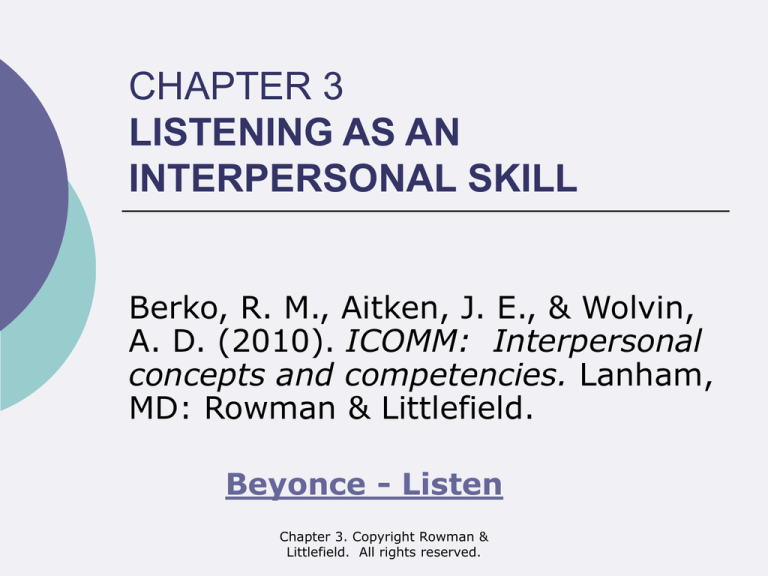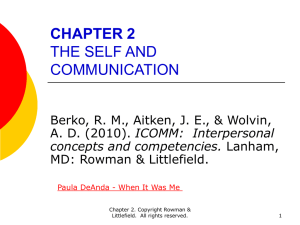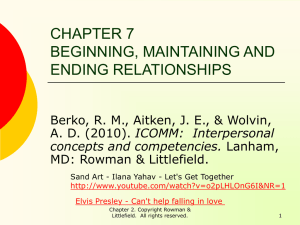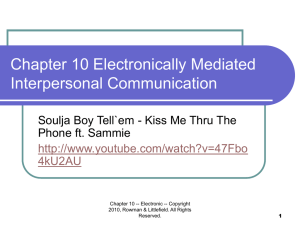
CHAPTER 3
LISTENING AS AN
INTERPERSONAL SKILL
Berko, R. M., Aitken, J. E., & Wolvin,
A. D. (2010). ICOMM: Interpersonal
concepts and competencies. Lanham,
MD: Rowman & Littlefield.
Beyonce - Listen
Chapter 3. Copyright Rowman &
Littlefield. All rights reserved.
The Problem
Most US Americans spend more
than half—as much as 80% of the
day hearing—but actively listening
only about half the time.
Unfortunately, they understand and
remember less than 25% of what
they hear.
Based on materials developed by Robert Montgomery as they appear in Berko, R.,
Rosenfeld, L., & Samovar, L. (1997). Connecting: A culture-sensitive approach to
interpersonal communication competency (2nd ed.). Fort Worth, TX: Harcourt Brace
College Publishers, p. 100.
Chapter 3. Copyright Rowman &
Littlefield. All rights reserved.
THE IMPORTANCE OF LISTENING
Personal relationships.
Education.
Business.
Chapter 3. Copyright Rowman &
Littlefield. All rights reserved.
THE LISTENING PROCESS
Reception
Feedback
Perception
Assignment of meaning
Attention
Chapter 3. Copyright Rowman &
Littlefield. All rights reserved.
PERCEPTION
Perceptual filter--screens what
you notice (perceive) and separates
what makes sense from what
doesn’t.
Selective perception--focus to
some specific information.
Chapter 3. Copyright Rowman &
Littlefield. All rights reserved.
The Role of Global or Linear
Dominance
Brain dominance.
Affects thinking and listening
Chapter 3. Copyright Rowman &
Littlefield. All rights reserved.
Linear learners or listeners
Logical.
Specific sequence.
Take information at face value.
Chapter 3. Copyright Rowman &
Littlefield. All rights reserved.
Global listeners or learners
Concrete.
Visual.
Spatial.
Generalized description.
Chapter 3. Copyright Rowman &
Littlefield. All rights reserved.
Talk about it:
Are you a global or linear listener?
Chapter 3. Copyright Rowman &
Littlefield. All rights reserved.
LISTENING EVALUATION
Differentiate factual statements
(those based on observable
phenomena or common acceptance)
from opinions (inferences or
judgments).
Ask questions and seek
clarification.
Recognize emotional biases.
Chapter 3. Copyright Rowman &
Littlefield. All rights reserved.
RESPONSE
Questions.
Feedback.
Chapter 3. Copyright Rowman &
Littlefield. All rights reserved.
LISTENING INFLUENCERS
Interpersonal communicator.
Message.
Channel.
Memory and time.
Chapter 3. Copyright Rowman &
Littlefield. All rights reserved.
Debate
Construct arguments to support one
position (that may be assigned),
then discuss.
1. The responsibility for listening
well is on the listener.
2. The responsibility for being
clear and interesting is on the
person doing most of the
talking.
Chapter 3. Copyright Rowman &
Littlefield. All rights reserved.
PURPOSES OF LISTENING
Discriminative listening,
distinguish among auditory and
visual stimuli.
Comprehension listening,
understand and remember.
Therapeutic listening, think
through a problem.
Chapter 3. Copyright Rowman &
Littlefield. All rights reserved.
Additional purposes of listening.
Critical listening, analyze and
judge.
Appreciative listening, simply
enjoy.
Compassionate listening, openminded and no judgment
Chapter 3. Copyright Rowman &
Littlefield. All rights reserved.
PARAPHRASE AND PROBE
The
You
You
You
You
issue is . . .
think . . .
want . . .
are feeling . . .
need . . .
Weingarten, R. U. (2006, November 12). Communication
with compassion: The art of listening. A report of the
Bikur Cholim Conference. Turn to me: Faces and
phases of Bikur Cholim. New York, p. 4.
Chapter 3. Copyright Rowman &
Littlefield. All rights reserved.
“There’s something about the
respectful silence and attention of
the listener that brings out feelings
that need comfort or affirmation.”
Borysenko, J. (2006, November 12). Guilt is the teacher, love is
the lesson, p. 78, as cited in Weingarten, U. Communication
with compassion: The art of listening. A report of the Bikur
Cholim Conference. Turn to me: Faces and phases of Bikur
Cholim. New York.
Chapter 3. Copyright Rowman &
Littlefield. All rights reserved.
LISTENING RESPONSE STYLES
Active, figure out key ideas while
creating mutual understanding.
Recommending, advice giver.
Information-seeking.
Critical, pass judgment.
Chapter 3. Copyright Rowman &
Littlefield. All rights reserved.
Discussion
How is your listening influenced by
your culture?
Chapter 3. Copyright Rowman &
Littlefield. All rights reserved.
In Chinese, note the similarities between the
words ear and heart as components of
listening.
Listening
聽
Ear
耳朵
Heart 心臟
Chapter 3. Copyright Rowman &
Littlefield. All rights reserved.
HIGH CONTEXT-LOW CONTEXT
CULTURES
Low: US
High: Japan
Video: Low and High Context Cultures
Source of chart:
http://www.gender
work.com/images/f
lags.gif
Chapter 3. Copyright Rowman &
Littlefield. All rights reserved.
Practice
Pair with a partner.
One person be the source and the
other the receiver. Talk about easy
topics, such as your major, things
you like to do, sports.
The listener needs to practice
questioning and paraphrasing.
After a few minutes, switch roles.
Chapter 3. Copyright Rowman &
Littlefield. All rights reserved.
LISTENING APPREHENSION
May be a long term disability.
Less able to interact effectively.
Worried about is how you will
respond.
Less thinking or preparing.
Chapter 3. Copyright Rowman &
Littlefield. All rights reserved.
SOLUTIONS TO LISTENER
APPREHENSION
Relax.
Take notes.
Paraphrase.
Prepare.
Chapter 3. Copyright Rowman &
Littlefield. All rights reserved.
IMPROVE YOUR LISTENING SKILLS
Recognize joint communication
responsibility.
Reserve judgment.
Be a tolerant listener.
Use engaging nonverbals.
Control distractions.
Chapter 3. Copyright Rowman &
Littlefield. All rights reserved.
SKILL IMPROVEMENT CONTINUED
Avoid egospeak. Egospeak is the “art of
boosting our own ego by speaking only
about what we want to talk about, and
not giving a hoot in hell about what the
[other] person is speaking about.”
A concept first discussed in Addeo, E., &
Burger, R. (1974). Egospeak. New York:
Bantam Books, p. xiv.
Chapter 3. Copyright Rowman &
Littlefield. All rights reserved.
Application Learning Activities
Discuss with a partner or small group
or complete on your own outside
class.
Chapter 3. Copyright Rowman &
Littlefield. All rights reserved.
GLOBAL OR LINEAR LISTENER
Based on the measure in the
chapter, what is you thinking
dominance and how might that
affect your listening?
What communication techniques
can you use to better adapt to a
listener who is different from you?
Chapter 3. Copyright Rowman &
Littlefield. All rights reserved.
MENTAL ATTENTIVENESS
Just for fun, complete this 54-item listening test
or find a different one on the Internet. You can
select "I don't want to answer" options regarding
the demographic data at the end of the test.
There are enough questions to help you think
about your listening behaviors in various
contexts. Given the importance of listening
effectively, how skilled are you? What do the
results suggest that you could do to improve
your listening skills?
http://www.queendom.com/queendom_tests/tra
nsfer?req=MXw3MDN8NTQ3MDkwN3wxfDE=&refe
mpt=1
Chapter 3. Copyright Rowman &
Littlefield. All rights reserved.
WILLINGNESS TO LISTEN
In US culture, we typically expect the
speaker to be responsible for effective
communication. In many cultures, the
listener is responsible. If you haven't
already taken the Willingness to Listen
measure, do that now. If you want to
change your communication effectiveness,
you can increase your willingness to
listen.
How will you do that in interpersonal
communication situations?
http://www.jamescmccroskey.com/measur
es/wtlisten.htm
Chapter 3. Copyright Rowman &
Littlefield. All rights reserved.
END
CHAPTER 3
LISTENING AS AN
INTERPERSONAL SKILL
Berko, R. M., Aitken, J. E., & Wolvin,
A. D. (2010). ICOMM: Interpersonal
concepts and competencies. Lanham,
MD: Rowman & Littlefield.
Chapter 3. Copyright Rowman &
Littlefield. All rights reserved.








